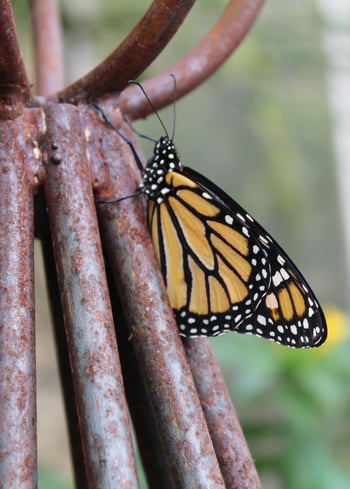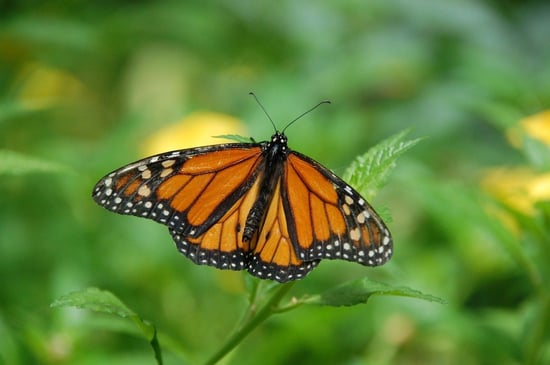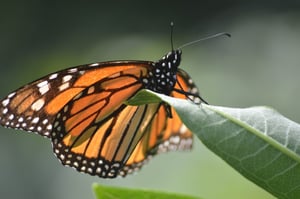
The monarch butterfly has become a poster child for climate change, habitat destruction and other environmental ills ... but could it become a beacon of hope as well? Chicago’s Field Museum is working hard to make it so.
(Download the free PDF report to take with you, and share it with your colleagues and friends!)
Too often, we dump urban and wild areas into distinct buckets, separating them from one another as though they’re naturally incompatible.
That’s never been the case, though. The earliest human settlements attracted animals that could coexist peacefully with their buildings and activities. Today, a glance out any window will reveal at least some signs of wildlife, from a bird’s nest in winter to a spring caterpillar.
If you live in the Midwest, you’ve no doubt noticed monarchs among your city’s urban wildlife. This iconic butterfly is facing severe threats today, with population numbers plummeting by 80-90 percent in the past several decades, but with our help an important pollinator could still rebound.
What kind of help? One of the most important things we can do for the monarch is study it. Understand its patterns. Track its numbers. Plant its food source.
Each of these goals lies at the heart of the Field Museum’s Monarch Community Science program. Recently we had the pleasure of catching up with Erika Hasle, a conservation ecologist at the Field Museum, to get her take on community science and the role it plays in a brighter, greener future.
-- READ MORE –
The City: A Refuge for Wildlife?
 Before we dive into talking about urban community science projects, it is useful to first discuss why we care about wildlife in cities at all. After all, as we pointed out above, many people harbor the belief that cities and nature are antithetical.
Before we dive into talking about urban community science projects, it is useful to first discuss why we care about wildlife in cities at all. After all, as we pointed out above, many people harbor the belief that cities and nature are antithetical.
Although it might seem that way, and many people (even some ecologists) discuss this division as though it’s a sharp and unyielding one, that’s not the case. Far from it.
In fact, as wild areas dwindle in the face of development, wildlife that used to reside there receives increasing pressure to make do with whatever habitat it can find. In many cases, that’s the very city to which the animal’s range was lost in the first place.
As explained in a recent paper on which Hasle collaborated, “As changes in land use and land cover sweep the planet, cities are becoming important refugia for certain wildlife populations. In recent years, urban planning has embraced the concept of ‘green infrastructure’ as a way to embed green space across metropolitan landscapes to draw on the inherent benefits nature provides to cities, as well as to create habitat for wildlife.”
To monarchs, Hasle says, that habitat is milkweed, which is why one of the Monarch Community Science Program’s prime objectives is to figure out how much there is within the Chicagoland area.
What Is the Monarch Community Science Project?
 “We received a grant through the Fish and Wildlife Service to look at monarch habitat at big cities and then in smaller cities,” Hasle says, “because there wasn’t a lot of data about how much milkweed there was in a place and what the density is.”
“We received a grant through the Fish and Wildlife Service to look at monarch habitat at big cities and then in smaller cities,” Hasle says, “because there wasn’t a lot of data about how much milkweed there was in a place and what the density is.”
Why is the number of stems important?
“There is a federal goal to add 1.6 billion milkweed stems to the Midwest, because that’s the number of stems needed to stabilize the population,” Hasle says. Stems were chosen because they are countable, and they are the unit on which other data is already based, though the team does acknowledge there are some shortcomings with this: “We understand that having milkweed in the context of other species is probably important, but that couldn’t be part of our original work.”
Overall, though, “we did was useful to establish that there is milkweed in cities and that’s what we could do at the time.” To wit: gathering volunteers in Chicago and surrounding areas to identify (or grow) patches of milkweed, then observe them at least once a week to take population counts and log them into the program’s database.
For those that don’t have access to milkweed on their own properties or balconies, the program advocates tracking nearby patches of milkweed, either in public areas or on private lands – with the landowner or property manager’s permission of course.
The main question the project tries to answer is whether a stem of milkweed in the city is as effective as one in another place for supporting butterflies, from egg to caterpillar to chrysalis to full butterfly-hood.
What Has the Project Discovered About Monarch Habitat?
 According to Hasle, “The early data is encouraging, that monarch caterpillars might have similar survival rates in cities as they do outside of cities.”
According to Hasle, “The early data is encouraging, that monarch caterpillars might have similar survival rates in cities as they do outside of cities.”
As of now, we have firm proof that there’s lots of milkweed in the Chicago area – and there is the potential to add a lot more, which is important.
“As we move toward a more and more urban world, having habitat within cities is going to be important,” Hasle says. “And it’s looking like cities provide good habitat. I think a lot of people don’t know that you can grow native plants in containers, that you can grow them in really small habitat spots, and that the pollinators find them. You don’t need a lot of space. You don’t need a big suburban yard. A patio or balcony can provide habitat.”
Moreover, data reflects the viability of many milkweed species as habitat, including:
- Common milkweed
- Butterfly milkweed
- Swamp milkweed
- Whorled milkweed
- Prairie milkweed
Some of these are harder to get than others, though, especially for certain demographics.
“There’s the impression that people in rich suburbs or older retired folks are the only ones who plant natives,” Hasle explains. “But the truth is, that’s who can get to a native plant sale on a weekday. This is one of the biggest challenges with native plants.”
To that end, the Field Museum is exploring multiple avenues for making plants more available to people, including collaborating with nearby universities to produce more stock.
Another amazing takeaway from the project so far?
“People are excited,” Hasle enthuses. “That’s been the weirdest thing for me working in the monarch world. I used to work in migratory antelope, and no one would call me on the weekend to talk about migratory antelope. But I had to stop sharing my cellphone number. People just kept calling!”
How Can We Use Our Urban Spaces Better?
 There’s no time like the present to capitalize on that excitement. To put our urban spaces to best use, it’s important to ask questions that are increasingly cropping up in the native gardening world: What exactly is a weed?
There’s no time like the present to capitalize on that excitement. To put our urban spaces to best use, it’s important to ask questions that are increasingly cropping up in the native gardening world: What exactly is a weed?
Lots of plants that we might dismiss as such are actually valuable flowering species to pollinators like the monarch. Indeed, if we included those in our classification of “flower,” it’s very possible that a block in urban Chicago has more flowers than one in a well-tended suburban neighborhood. Guess how much butterflies care about affluence and curb appeal?
Exactly: not at all.
Getting humans to agree is a little harder, though.
“We’ve seen multiple news articles about folks who have well-cared-for, well-planted native gardens that have been ticketed by the city for weeds,” Hasle says. “It’s an important thing that people come to understand that is a cared-for landscape, that it’s not harboring rats or filled with dangerous snakes.”
Another way to embrace the urban landscapes available for butterfly habitat is to make programs like this one inclusive.
“We’re running our program in Spanish and English. We’re making a conscious effort to reach out to the Latinx community,” Hasle points out. Doing so can help change the impression that conservation “is just for affluent white communities. Everywhere, and certainly in cities, we need to make a conscious effort to reach out to all communities.”
What can you do in the meantime? Hasle recommends checking out iNaturalist, an app created by National Geographic and the California Academy of Sciences to help budding conservationists identify, share and discuss what they see in their environments.
And if you live in Chicagoland, consider becoming a community scientist. The Monarch Community Science program hopes to turn their dozens of volunteers from this last year into 500 or more – and you could be the difference.
In the meantime, feel free to reach out to the Field Museum or Ecogardens with questions, comments or cute caterpillar pics. We’re open to all of the above, so happy hunting!
(And don't forget to take the free PDF with you when you go!)

